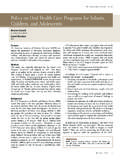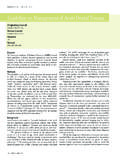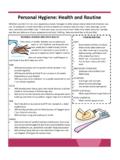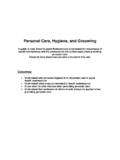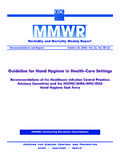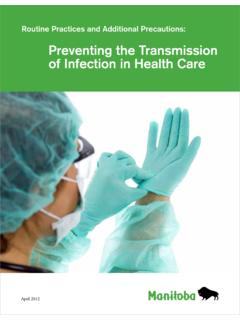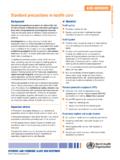Transcription of Guideline on Adolescent Oral Health Care - …
1 AMERICAN ACADEMY OF PEDIATRIC DENTISTRY. Guideline on Adolescent oral Health Care Originating Committee Clinical Affairs Committee Review Council Council on Clinical Affairs, Committee on the Adolescent Adopted 1986. Revised 1999, 2003, 2005, 2010, 2015. Purpose effective treatment planning. Familiarity with the patient's The American Academy of Pediatric Dentistry (AAPD) recog- medical history is essential for decreasing the risk of aggravating nizes that the Adolescent patient has unique needs. This a medical condition while rendering dental care. If the parent Guideline addresses these unique needs and proposes general is unable to provide adequate details regarding a patient's recommendations for their management.
2 This Guideline serves medical history, consultation with the medical Health care as a summary document; more detailed information regard- provider may be indicated. The practitioner also may need to ing these topics is provided in referenced AAPD oral Health obtain additional information confidentially from an adoles- policies and clinical practice guidelines . cent Methods Recommendations This Guideline is an update of the previous document, revised This Guideline addresses some of the special needs within the in 2010. The update includes an electronic search using the Adolescent population and proposes general recommendations following parameters: Terms: Adolescent combined with for their management.
3 Dental, gingivitis, oral piercing, sealants, oral Health , caries, tobacco use, dental trauma, orofacial trauma, periodontal, Caries dental esthetics, smokeless tobacco, nutrition, and diet; Fields: Adolescence marks a period of significant caries activity for all; Limits: humans, English, clinical trials. The reviewers many individuals. Research suggests that the overall caries agreed upon the inclusion of 92 electronic and hand searched rate is declining, yet remains highest during ,11. articles that met the defined criteria. When data did not Immature permanent tooth enamel,12 a total increase in sus- appear sufficient or were inconclusive, recommendations were ceptible tooth surfaces, and environmental factors such as based upon expert and/or consensus opinion by experienced diet, independence to seek care or avoid it, a low priority for researchers and clinicians.
4 oral hygiene, and additional social factors also may contribute to the upward slope of caries during ,13-16 It is Background important for the dental provider to emphasize the positive There is no standard definition of Adolescents are effects that fluoridation, professional topical fluoride treatment, defined very broadly as youths between the ages of 10 to 18. routine professional care, patient education, and personal Using this definition, there were approximately million hygiene can have in counteracting the changing pattern of adolescents in the United States in 2008, according to the caries in the Adolescent ,6.
5 US Census The Adolescent patient is recognized as having distinctive needs3,4 due to: (1) a potentially high caries Management of caries rate; (2) increased risk for traumatic injury and periodontal Primary prevention disease; (3) a tendency for poor nutritional habits; (4) an in- Fluoride: Fluoridation has proven to be the most economical creased esthetic desire and awareness; (5) complexity of com- and effective caries prevention measure. The Adolescent can bined orthodontic and restorative care (eg, congenitally benefit from fluoride throughout the teenage years and into missing teeth); (6) dental phobia; (7) potential use of tobacco, early adulthood.
6 Although the systemic benefit of fluoride alcohol, and other drugs; (8) pregnancy; (9) eating disorders; incorporation into developing enamel is not considered neces- and (10) unique social and psychological sary past 16 years of age, topical benefits can be obtained Treatment of the Adolescent patient can be multi-faceted through optimally-fluoridated water, professionally-applied and complex. Accurate, comprehensive, and up-to-date medi- and prescribed compounds, and fluoridated ,18. cal and social histories are necessary for correct diagnosis and CLINICAL PRACTICE guidelines 151. REFERENCE MANUAL V 37 / NO 6 15 / 16.
7 Recommendations: The Adolescent should receive maximum Secondary prevention fluoride benefit dependent on risk assessment:18,19 Professional preventive care: Professional preventive dental Brushing teeth twice a day with a fluoridated dentifrice care, on a routine basis, may prevent oral disease or disclose is recommended to provide continuing topical existing disease in its early stages. The Adolescent patient Professionally-applied fluoride treatments should be based whose oral Health has not been monitored routinely by a on the individual patient's caries-risk assessment, as de- dentist may have advanced caries, periodontal disease, or other termined by the patient's dental ,20 oral involvement urgently in need of professional evaluation Home-applied prescription strength topical fluoride prod- and extensive treatment.
8 Ucts [eg, percent stannous fluoride gel, percent Recommendations: fluoride gel or paste, percent sodium fluoride (NaF) Timing of periodic oral examinations should take into rinse] may be used when indicated by an individual's consideration the individual's needs and risk indicators caries pattern or caries risk to determine the most cost-effective, disease-preventive Systemic fluoride intake via optimal fluoridation of drink- benefit to the ing water or professionally-prescribed supplements is Initial and periodic radiographic examination should be a recommended to 16 years of age. Supplements should part of a clinical evaluation.
9 The type, number, and fre- be given only after all other sources of fluoride have been quency of radiographs should be determined only after an oral examination and history taking. Previously ex- posed radiographs should be available, whenever possible, oral hygiene: Adolescence can be a time of heightened caries for comparison. Currently accepted guidelines for radio- activity and periodontal disease due to an increased intake of graphic exposures (ie, appropriate films based upon cariogenic substances and inattention to oral hygiene pro- medical history, caries risk, history of periodontal disease, ,21 Tooth brushing with a fluoridated dentifrice and and growth and development assessments) should be flossing can provide benefit through the topical effect of the fluoride and plaque removal from tooth Recommendations: Restorative dentistry.
10 In cases where remineralization of non- Adolescents should be educated and motivated to main- cavitated, demineralized tooth surfaces is not successful, as tain personal oral hygiene through daily plaque removal, demonstrated by progression of carious lesions, dental restora- including flossing, with the frequency and technique tions are necessary. Preservation of tooth structure, esthetics, based on the individual's disease pattern and oral hygiene and each individual patient's needs must be considered when ,22 selecting a restorative Molars with extensive caries Professional removal of plaque and calculus is recom- or malformed, hypoplastic enamel for which traditional mended highly for the Adolescent , with the frequency amalgam or composite resin restorations are not feasible.
